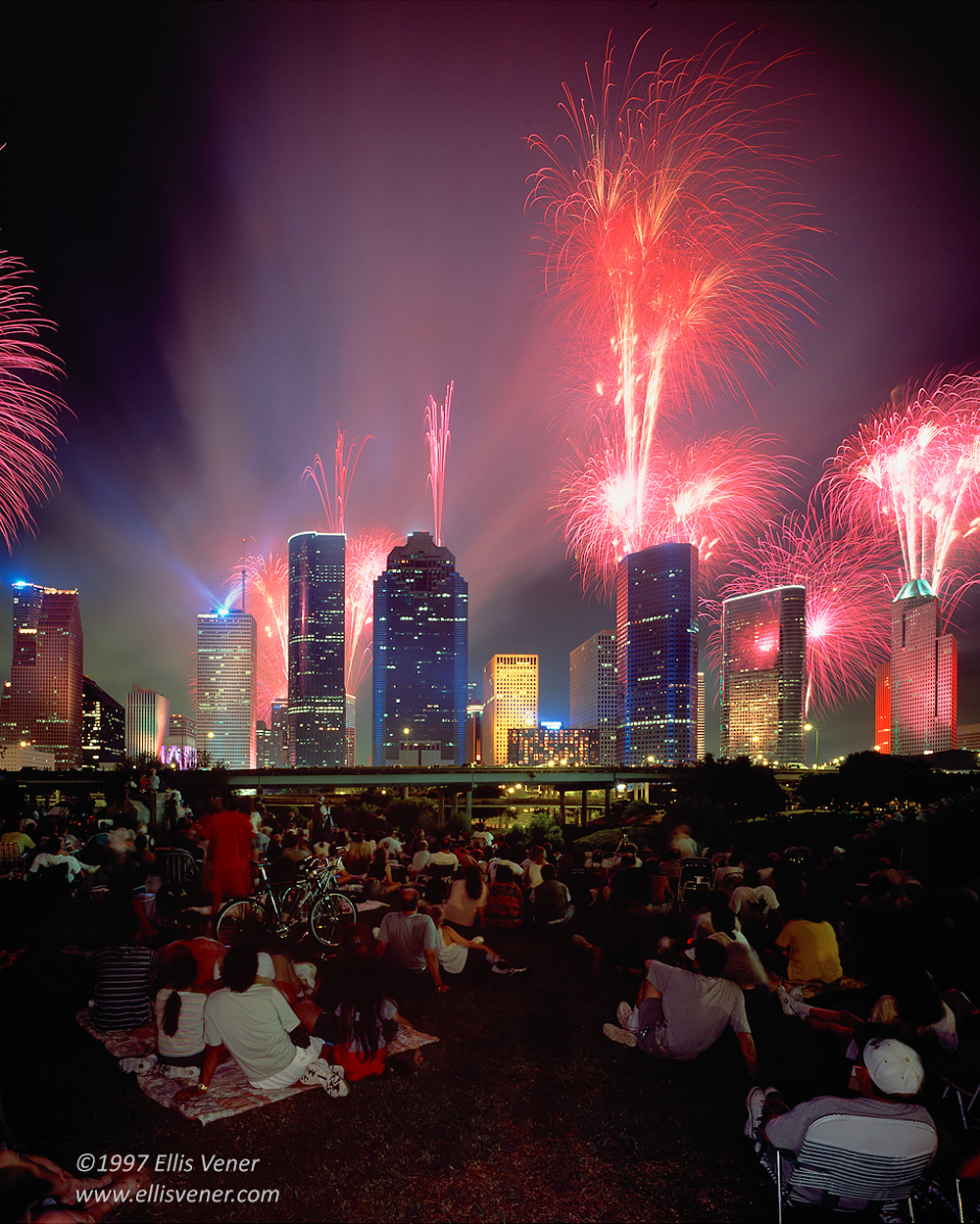Last Updated on 07/01/2018 by Mark Beckenbach
Photographing fireworks on film surely does require more work than when shooting digital.
With pyrotechnics, the stars of the show are quite literally shooting stars (“stars” being the fireworks industry’s term for those bits of flying sparkly fire). As in any performance, stars need a stage, and in a photograph the stage is everything else in the frame: the dark sky, buildings, or monuments, even your fellow audience members watching the show.
Although shooting on film eliminates digital photography’s near immediate feedback loop, it has other advantages. If you use color transparency film, you give up dynamic range with film and the ability to easily manipulate color in exchange for sensationally saturated color against a very dark background. The challenge is to get the exposure right while shooting without resorting to post-shoot processing manipulations. On the other hand, ISO 100 to 400 color negative films have an inherently large highlight range and lower contrast which is great for recording the color and details of the bright but short-lived streaks.
Before You Shoot
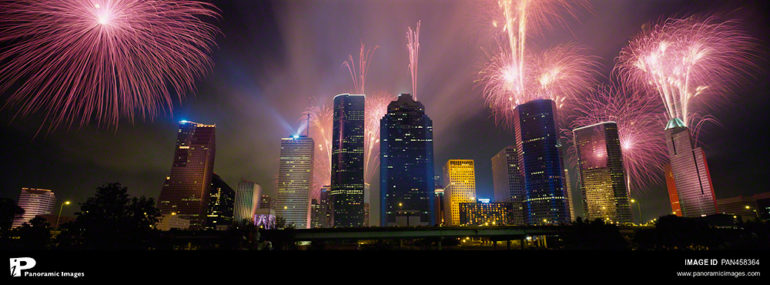
Shot on medium format Fuji Velvia 50 in a customized V-Pan Mark III 6x17cm format camera with a Rodenstock Grandagon 90mm f/4.5 lens
Photographing fireworks is always a bit of a crapshoot. You are at the mercy of things you cannot control, like wind and weather and the show’s choreography. But doing some basic preparation can tip the odds more in your favor.
First: scout the location. In a town or city, find out where the rockets launch from and look at a map to figure out where the bursts are likely to be in relation to the skyline. You can take this a step further and consider what will form the base of your image. Context tells story. Do you want a crowd of people in front of you? Are there any bodies of water that will reflect the glow of the stars and streamers? If possible, go visit the location to envision things for yourself.
Second: prepare. Before leaving for any location I like to make checklists to make sure I have the equipment I need, including a flashlight, extra batteries, and film; lots of water to drink and snacks; sunscreen, a hat, and a blanket to sit on. If there is the possibility of rain bring trash bags to cover the gear, and either a rain coat or poncho.
Third: Get to your location early. I cannot emphasize this enough. Try to get there and set up in your chosen spot before the crowds get there.
Just as the show starts check your gear again. Check focus, battery levels, and basic framing. Have a plan of action. There is a saying among military historians and war generals that preaches the gospel of “no plan survives first contact with the enemy” and when you photograph firework shows, time is your enemy. Still it is better to have a plan to improvise from rather than have no plan at all.
Negative vs Positive
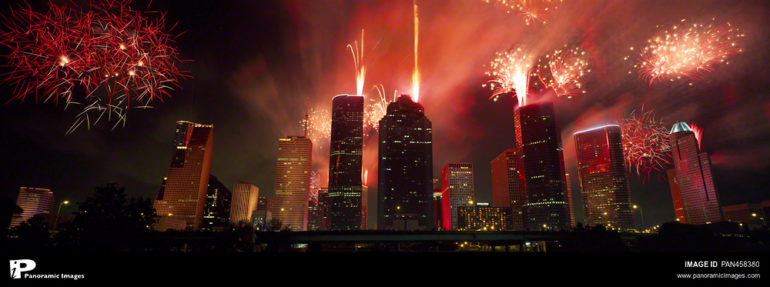
Both negative and positive color film share two interrelated long exposure qualities which are helpful for creative fireworks photography. Unlike with digital cameras, leaving the shutter open for extended periods does not increase the noise to signal ratio the way it does with digital photography. Also, unlike digital media, you have to deal with reciprocity failure. Reciprocity failure is usually a film shooter’s bane when long exposures are needed but when photographing fireworks, it becomes a virtue by helping you control the relative brightness of areas lit by street lights and the like.
Reciprocity failure – a progressive lowering of a film’s sensitivity to light during progressively long exposures- helps preserve critical detail in the mid-tones of areas lit by constant lights. It does not affect the fireworks themselves (those only last a few seconds) but does influence objects lit by continuous light like buildings or crowds. Reciprocity exposure failure with E-6 transparency films is predictable; if a meter says expose for 3 seconds, expose for 4 seconds; if 4 seconds, expose for 6-7 seconds; if 8 seconds is indicated, expose for 21; and if a meter tells you to expose for 15 seconds, expose for 42 to 45 seconds; and so on. I had to memorize these compensation factors back in the early ‘80s and they still hold true today. Reciprocity failure also has a slight impact on color but when shooting firework shows, it is not worth worrying about.
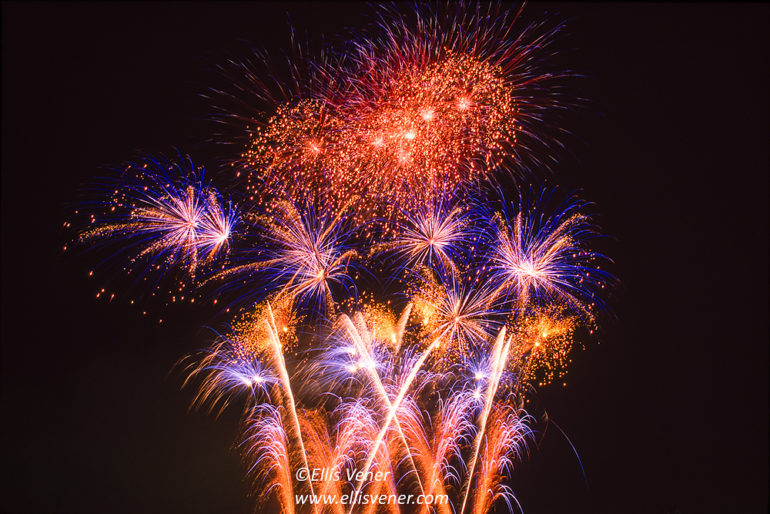
CamScan made with a Nikon D850, Nikon PB-6 bellows, Rodenstock APO-Rodagon 75mm f/4 D lens, and PRL Lighting Lustra L-50 daylight balance LED light source
Pro Tip: One way to exploit this is locking the shutter open while covering and uncovering the lens during the prolonged exposure with an opaque card as an effective method of creating a unique image containing multiple shell bursts.
35mm, 120, Large Format?
There is no single perfect film format for photographing firework shows. I have had great success using large format, medium format 6x17cm panoramic cameras, and standard 35mm cameras. Think about these factors when deciding which lens to use: distance from the display, making sure you do not crop off the streamers, and what, if anything, you also want in the shot besides the pyrotechnics.
While modern cameras with electronically controlled shutters have internally controlled exposure times extending down to 30 seconds and a “B” (for bulb) shutter speed setting, older cameras with mechanical shutters usually bottom out at 1 second but have a “T” (for timed) mode as well as a “B” setting. The difference between B and T is that “B” keeps the shutter open as long as the shutter release is depressed while “T” opens the shutter with one press and closes it with a second press. “T” is important for exploiting film’s ability for extremely long exposures and when photographing a fireworks display. A very long exposure allows for a pair of interesting ways for controlling the light coming through the lens.
Exposures on Film
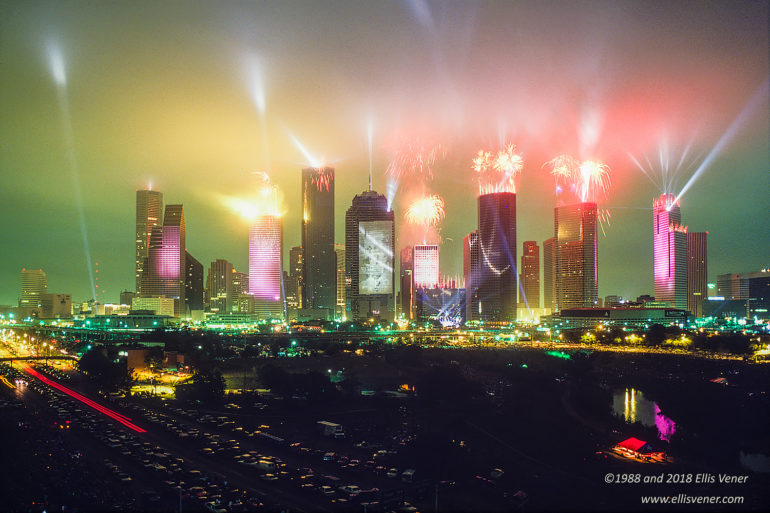
The original image was made using a long exposure dodging and burning in camera using my drivers license held over the front of the lens to hold detail in the sky and in the dark areas from the base of the skyline and the foreground.
The original was copied to raw digital format using a Nikon D850 camera and a Rodenstock APO-Rodagon 75mm f/4-D lens, mounted on a Nikon PB-6 bellows. Light source: PRL Lighting Lustra L50 daylight balanced LED array. This image is a high dynamic range composite of 5 raw images using Adobe Lightrooms PhotoMerge HDR algorithm and dust spotted in Adobe Photoshop CC 2018.
You can take the previously stated idea a bit further and control the exposure time of small areas in the frame by using an opaque card across parts of the lens. In-camera dodging and burning to build up or reduce exposure is a technique I carried over from my years of black and white printing in a darkroom. It takes some trial and error and knowledge of the subject to get it right, but it is a useful technique when photographing fireworks and skylines.
Exposure guidelines for shooting pyrotechnical displays with either film or digital media are pretty straightforward:
- Remember that you are photographing light sources so use films with a low ISO. ISO 50 to 100 films are ideal.
- Because you are photographing evanescent light sources, stick with f-stops in the f8 to f11 range. Wider apertures will result in overexposure and smaller apertures will underexpose the last filaments.
- To capture the streamers and stars you will need longish exposures. Depending on the type of effect being created by a particular firework, individual streamers burn only for a few seconds but you need to open the shutter before the shell explodes to capture the full dazzle.
- Make sure you pre-focus at infinity, and if your camera has autofocus turn it off.
- Use a tripod or other solid support. If you are setting up close to the launchers or will be close to where the bombs are bursting in air, having some ballast on the tripod is not a bad idea to improve sharpness. The whump from the explosions can cause camera shake. The aerial streaks will not show it, but details lit by other lights may dance a jig.
- If you have either a wired or wireless remote1, these are especially useful in multi-camera setup if you feel comfortable managing them all.
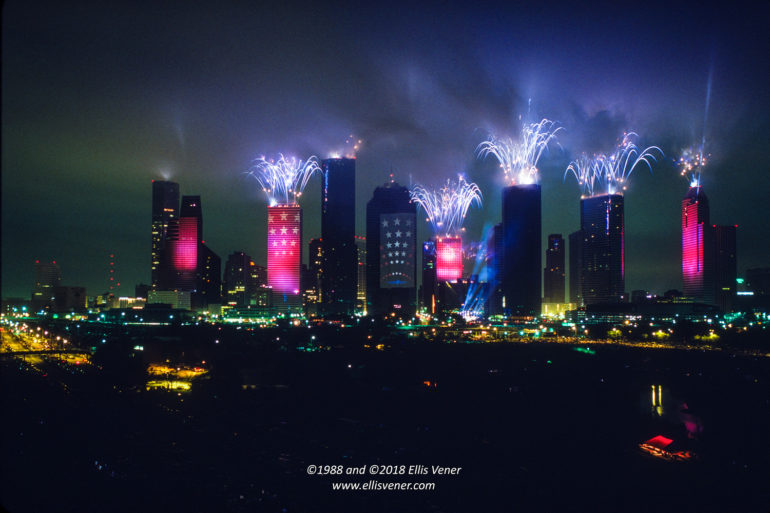
The original image was made using a long exposure with no localized exposure manipulation.
The original was copied to raw digital format using a Nikon D850 camera and a Rodenstock APO-Rodagon 75mm f/4-D lens, mounted on a Nikon PB-6 bellows. Light source: PRL Lighting Lustra L50 daylight balanced LED array. This image is a high dynamic range composite of 5 raw images using Adobe Lightroom’s PhotoMerge HDR algorithm and dust spotted in Adobe Photoshop CC 2018.
Last thing: Do not get so caught up in your gear that you forget to have fun and enjoy the spectacle.


